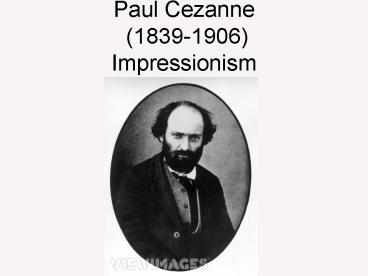Paul Cezanne 18391906 Impressionism PowerPoint PPT Presentation
1 / 12
Title: Paul Cezanne 18391906 Impressionism
1
Paul Cezanne (1839-1906)Impressionism
2
Childhood
- Born to wealthy parents in Aix-en-Provence
(a-un-pro-va-ns) near the Mediterranean coast,
Cezanne (say-zan) had a privileged childhood. He
was well-educated at a boarding-school. - To please his father, he studied law for two
years, but eventually convinced his family to
support his desire to be an artist. - ----------------------------------
- This is an early picture of his father. What is
the source of light? Does he look wealthy? Why?
3
Romantic period
- He followed his school friend, Emile Zola, to
Paris for two years. At the time, he was
painting in a dark, thick paint. This picture is
of his mother and sister. - In Paris, he became friends with Pissaro
(piz-are-o), an important Impressionist. Under
Pissaros influence, Cezannes approach to his
canvasses changed to lighter colors and more
complex shapes. - ----------------------------------------
- Does this look like your home? How many patterns
do you see?
4
Constructive period
- His colors and brushwork lightened up, as did his
topics. - Even at this relatively early stage, his interest
in the volume and solidity of shapes places him
apart from other Impressionists. - This is a picture of his wife.
- --------------------------------
- Does the chair seem real?
- Do you sense that there is a body under the
clothes? - Where is the light source?
5
Mature work
- After 1880, Cezanne largely retired to the
country after inheriting his fathers fortune. - He devoted himself to moving carrying the
Impressionistic aims into something solid and
durable, like the art of the museums. - The top picture here sold for 28.6 million in
1993. - -------------------------------------
- Pictures of objects are called still-life. Can
you see why? Does the fruit look real? What
about the cloth?
6
Conquer Paris with an apple
- He believed that all forms in nature were based
on the cone, the sphere or the cylinder. - He studied optics, particularly binoclularism
the way each eye works separately and together to
create depth perception. - Look at this work through each eye separately,
and then together. - -----------------------------------
- What shapes do you see in the picture? Do they
seem to be actual objects that would feel heavy
if you picked them up?
7
Sainte-Victoire
- In 1880, his brother-in-law bought a house near
Ste.-Victoire (san-vic-toi), in southern France. - To Cezanne, the mountain provided an ideal
subject to show the volume, permanence, and
firmness that he believed were the purpose of
art. - Notice the lack of people and movement.
- -------------------------------------
- Do you see a sphere? A cone? A cylinder?
- Do you like this picture? Does is feel realistic?
8
Ste. Victoire
- Cezanne used planes of color and small
brushstrokes to buildup complex forms. - His works combine both an intense realism, and a
depth that verges on abstract. - What shapes do you see? Are these pictures
painted at the same time of year? Why does he
show no people?
9
The Card Players
- Cezanne painted both landscapes and figures.
- Here, the bottle divides the picture,
highlighting the dark and light shades in the
mens clothes. - His later portraits are much more about volume
and color than the actual people. Notice the
fullness and solidity of the players jackets. - -----------------------------------
- What kinds of shapes do you see? How does the
use of light and dark shadows help highlight the
volume?
10
Self-Portrait
- Cezanne paints himself as an intense, wealthy
Frenchman. The turban was a fashion of the day. - Cezanne spent a long time on each of his
canvasses. Sometimes the fruit in his
still-lives rotted before the picture was
completed. - He completed many works, which are found in
museums throughout the world. - ------------------------------------
- Do you feel he is looking directly at you? Does
he seem confident?
11
Later life
- After 1890, he became more of a recluse. He
retreated to the country, foregoing even
occasional trips to Paris. - He fell out with friends and family, including a
bitter fight with his friend Zola. - In 1906 he was caught in a rainstorm while
walking back from his studio. He contracted
pneumonia and died several days later. - By the time of his death, artists were making
pilgrimages to his home celebrating his genius.
12
The Father of Us All
- Picasso famously said Cezanne was the father of
us all--truly a giant to the artists of the 20th
century. - Cubism often points to him as the starting point.
- Artist such as Braque, Gris, Picasso, Matisse and
many others point to him as the first to show a
new path in art that emphasizes shape and volume. - -------------------------------------
- What shapes do you see? Do they feel solid and
real? What about the perspective? Is the river
further away?

